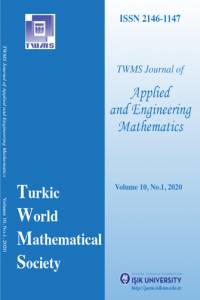VULNERABILITY IN NETWORKS
Recently dened exponential domination number is reported as a new mea- sure to graph vulnerability. It is a methodology, emerged in graph theory, for vulner- ability analysis of networks. Also, it gives more sensitive results than other available measures. Exponential domination number has great signicance both theoretically and practically for designing and optimizing networks. In this paper, it is studied how some of the graph types perform when they suer a vertex failure. When its vertices are corrupted, the vulnerability of a graph can be calculated by the exponential domination number which gives more information about the characterization of the network.
Keywords:
Graph vulnerability, network design and communication, domination, expo- nential domination number, robustness thorn graphs.,
___
- [1] Aytac, A. and Atay, B., (2016), On Exponential Domination of Some Graphs, Nonlinear Dynamics and Systems Theory, 16(1), pp. 12-19.
- [2] Aytac, A. and Turaci, T., (2015), Vulnerability Measures of Transformation Graph G xy+, International Journal of Foundations of Computer Science, Vol. 26, issue No 6, pp. 667- 675.
- [3] Haynes, T. W., Hedeniemi, S. T., Slater, P. J., (1998), Domination in graphs, Advanced Topic, Marcel Dekker, Inc, New York.
- [4] Bauer, D., Harary, F., Nieminen J. and Suffel C.L., (1983), Domination alteration sets in graph, Discrete Math., 47, pp. 153-161.
- [5] Slater P.J., (1976), R-Domination in graphs, J. Assoc. Comput. Mach., 23, 446-450.
- [6] Dankelmann, P., Day, D., Erwin, D., Mukwembi, S., Swart, H., (2009), Domination with exponential decay, Discrete Mathematics, 309, 5877-5883.
- [7] Anderson, M., Brigham, R. C., Carrington, J. R., Vitray, R. P., Yellen J., (2009), On Exponential Domination of CmxCn, AKCE J. Graphs. Combin., 6, No. 3, pp. 341-351.
- [8] West, D. B., (2001), Introduction to Graph Theory, Prentice-Hall, NJ.
- [9] Chartrand G., Lesniak, L., (1986), Graphs and Digraphs, Second Edition, Wadsworth, Monterey.
- [10] Gutman, I., (1998), Distance of thorny graphs, Publ. Inst. Math., (Beograd), 63(31 − 36), 73-74.
- [11] Henning, Michael A., Jager, S., Rautenbach, D., (2017), Relating domination, exponential domination, and porous exponential domination, Discrete optimization, 23, pp:81-92.
- [12] Goddard, W., Henning, M., McPillan, C., (2014), The disjunctive domination number of a graph, Quaest. Math., 37, pp. 547-561.
- [13] Chv`atal, V., (1973), Tough graphs and Hamiltonian circuits, Discrete Mathematics, 5, 215-228.
- [14] Barefoot, C. A., Entringer, R. and Swart, H., (1987), Vulnerability in graphs–a comparative survey, J. Combin. Math. Combin. Comput., 1 13-22.
- [15] Woodall, D. R., (1973), The binding number of a graph and its Anderson number, J. Combin. Theory Ser. B, 15, 225-255.
- [16] Jung, H. A., (1978), On a class of posets and the corresponding comparability graphs, Journal of Combinatorial Theory, Series B24(2), 125-133.
- ISSN: 2146-1147
- Başlangıç: 2010
- Yayıncı: Turkic World Mathematical Society
Sayıdaki Diğer Makaleler
S. NAZ, S. ASHRAF, H. RASHMANLOU
